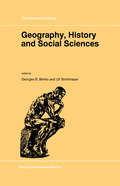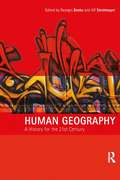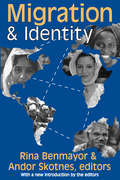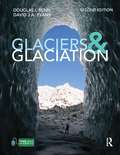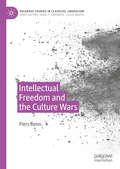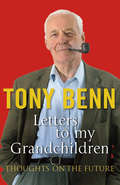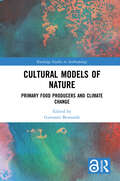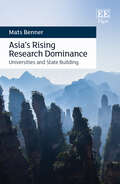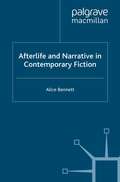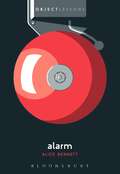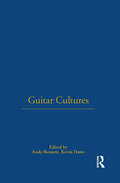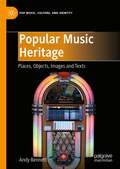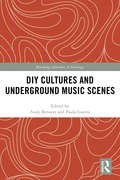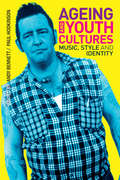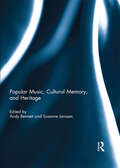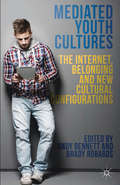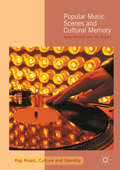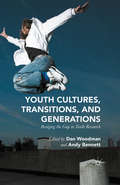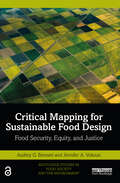- Table View
- List View
Geography, History and Social Sciences (GeoJournal Library #27)
by Georges B. Benko Ulf StrohmayerGeorges Benko «Societies are much messier than our theories of them» Michael Mann The Sources of Social Power 1 Towards a unified social theory Why are there communication problems between the different disciplines of the social sciences? And why should there be so much misunderstanding? Most probably because the encounter of several disciplines is in fact the encounter of several different histories, and therefore of several different cultures, each interpreting the other according to the code dictated by its own culture. Inevitably geographers view other disciplines through their own cultural filter, and even a benevolent view remains 'ethnocentric'. It was in order to avoid such ethnocentricity that Femand Braudel called for more unity among the social sciences in 1958 : «l wish the social sciences . . . would stop discussing their respective differences so much . . . and instead look for common ground . . . on which to reach their first agreement. Personally I would call these ways : quantification, spatial awareness and 'longue duree'». In its place at the center of the social sciences, geography reduces all social reality to its spatial dimensions. Unfortunately, as a discipline, it considers itself all too often to be in a world of its own. There is a need in France for a figure like Vidal de la Blanche who could refocus attention away from issues of time and space, towards space and social reality. Geographic research will only take a step forward once it learns to address the problems facing all the sciences.
Human Geography: A History for the Twenty-First Century
by Georges Benko Ulf Strohmayer'Human Geography' examines the major trends, debates, research and conceptual evolution of human geography during the twentieth century. Considering each of the subject's primary subfields in turn, it addresses developments in both continental European and Anglo-American geography, providing a cutting-edge evaluation of each.Written clearly and accessibly by leading researchers, the book combines historical astuteness with personal insights and draws on a range of theoretical positions. A central theme of the book is the relative decline of the traditional subdisciplines towards the end of the twentieth century, and the continuing movement towards interdisciplinarity in which the various strands of human geography are seen as inextricably linked.This stimulating and exciting new book provides a unique insight into the study of geography during the twentieth century, and is essential reading for anyone studying the history and philosophy of the subject.
Migration and Identity: Volume Iii: Migration And Identity (International Yearbook Of Oral History And Life Stories Ser. #Vol. 3)
by Rina Benmayor Andor SkotnoesThe theme of Migration and Identity is of special concern at a time both of massive worldwide migration and of apparently intensifying national, ethnic, and racial conflicts. Problems of migration and the resulting reconfigurations of social identity are fundamental issues for the twenty-first century. This volume spans the whole complex global web of migratory patterns with contributions linking Africa, Asia, Australia, Europe, North and South America, without losing the particularities of local and personal experience.This paperback edition in the Memory and Narrative series explores these issues and the sustaining or abandoning of memory and identity as people move between fundamentally different cultures, in a number of recent social settings, from a number of methodological perspectives. These focused "case studies" offer glimpses into the interior migration experiences, into the processes of constructing and reconstructing identity without forgetting that, both theoretically and empirically, the problem of identity is complex and multifaceted. All of the essays rely heavily on oral history and personal testimony, highlighting the experience of individuals and small groups, without ignoring the tension that exists between the local and the global.Memories of oppression or totalitarianism are one of the driving forces behind some of these migrations; and the transmission of memories and myths between family generations is one of the ways in which migrations are interpreted. In looking both backward and forward, Migration and Identity, offers an acute view of migratory patterns and their impact on the newcomers and the local cultures. It will be of interest to cultural and oral historians and researchers of concerned with migration and integration.
Glaciers and Glaciation, 2nd edition
by Douglas Benn David J EvansGlaciers and Glaciation is the classic textbook for all students of glaciation. Stimulating and accessible, it has established a reputation as a comprehensive and essential resource.In this new edition, the text, references and illustrations have been thoroughly updated to give today's reader an up-to-the minute overview of the nature, origin and behaviour of glaciers and the geological and geomorphological evidence for their past history on earth.The first part of the book investigates the processes involved in forming glacier ice, the nature of glacier-climate relationships, the mechanisms of glacier flow and the interactions of glaciers with other natural systems such as rivers, lakes and oceans.In the second part, the emphasis moves to landforms and sediment, the interpretation of the earth's glacial legacy and the reconstruction of glacial depositional environments and palaeoglaciology.
Glaciers and Glaciation, 2nd edition
by Douglas Benn David J EvansGlaciers and Glaciation is the classic textbook for all students of glaciation. Stimulating and accessible, it has established a reputation as a comprehensive and essential resource.In this new edition, the text, references and illustrations have been thoroughly updated to give today's reader an up-to-the minute overview of the nature, origin and behaviour of glaciers and the geological and geomorphological evidence for their past history on earth.The first part of the book investigates the processes involved in forming glacier ice, the nature of glacier-climate relationships, the mechanisms of glacier flow and the interactions of glaciers with other natural systems such as rivers, lakes and oceans.In the second part, the emphasis moves to landforms and sediment, the interpretation of the earth's glacial legacy and the reconstruction of glacial depositional environments and palaeoglaciology.
Intellectual Freedom and the Culture Wars (Palgrave Studies in Classical Liberalism)
by Piers BennThis book offers a sustained and vigorous defence of free expression and objective enquiry situated in the context of the current culture wars. In the spirit of J. S. Mill, Benn investigates objections to the ideal of free expression in relation to harm and offence, reaching broadly liberal conclusions with reference to recent examples of attempts to curb free speech on university campuses. Accepting that some expressions can cause non-physical harm, Benn also considers objections to free speech based on certain understandings of power and privilege. In its exploration and rejection of arguments against the possibility of obtaining objective truth, the book navigates hotly contested fields of contemporary debate, including feminism and identity politics. It challenges the dogma of social constructionism and examines current notions of identity, arguing that a case for fairness can be made without appealing to them. Offering a qualified endorsement of friendship between ideological opponents, Benn highlights common obstacles to civil and rational discussions, concluding with a rational, moral, and broadly spiritual solution to the cultural combat that monopolises present-day society.
Letters To My Grandchildren: Thoughts On The Future
by Tony BennAs a diarist I have chronicled the time through which I have lived in meticulous detail: but all that is history. What matters now is the future for those who will live through it.The past is the past but there may be lessons to be learned which could help the next generation to avoid mistakes their parents and grandparents made.Certainly at my age I have learned an enormous amount from the study of history - not so much from the political leaders of the time but from those who struggled for justice and explained the world in a way that shows the continuity of history and has inspired me to do my work.Normality for any individual is what the world is like on the day they are born. The normality of the young is wholly different from the normality of their grandparents.It is the disentangling of the real questions from the day to day business of politics that may make sense for those who take up the task as they will do.Every generation has to fight the same battles as their ancestors had to fight, again and again, for there is no final victory and no final defeat. Two flames have burned from the beginning of time - the flame of anger against injustice and the flame of hope. If this book serves its purpose it will fan both flames.
Cultural Models of Nature: Primary Food Producers and Climate Change (Routledge Studies in Anthropology)
by Giovanni BennardoDrawing on the ethnographic experience of the contributors, this volume explores the Cultural Models of Nature found in a range of food-producing communities located in climate-change affected areas. These Cultural Models represent specific organizations of the etic categories underlying the concept of Nature (i.e. plants, animals, the physical environment, the weather, humans, and the supernatural). The adoption of a common methodology across the research projects allows the drawing of meaningful cross-cultural comparisons between these communities. The research will be of interest to scholars and policymakers actively involved in research and solution-providing in the climate change arena.
Cultural Models of Nature: Primary Food Producers and Climate Change (Routledge Studies in Anthropology)
by Giovanni BennardoDrawing on the ethnographic experience of the contributors, this volume explores the Cultural Models of Nature found in a range of food-producing communities located in climate-change affected areas. These Cultural Models represent specific organizations of the etic categories underlying the concept of Nature (i.e. plants, animals, the physical environment, the weather, humans, and the supernatural). The adoption of a common methodology across the research projects allows the drawing of meaningful cross-cultural comparisons between these communities. The research will be of interest to scholars and policymakers actively involved in research and solution-providing in the climate change arena.
Asia’s Rising Research Dominance: Universities and State Building
by Mats BennerProviding an in-depth and cutting-edge investigation into the rise of Asian research practices and paradigms, Mats Benner examines how this rise has been accomplished, what effects it has had, and how it has shaped universities across seven Asian countries.Broad and comprehensive, chapters analyse the research and education systems of China, Hong Kong, India, Japan, Macau, Singapore, South Korea, and Taiwan, considering how their universities operate, their models and policy priorities. Benner studies the historical, social and political causes behind the variations between these countries, before highlighting the effects of globalization on education, research and innovation. Assessing whether we are witnessing a tectonic shift in how and where education and research are carried out, the book ultimately concludes that regional disparities will remain, but that practices and priorities are becoming increasingly similar in the process of globalization.With Asia showing an increasingly marked presence in research and in scientific and technological capability, this timely book will be invaluable to university policy makers looking to innovate their education and research models, alongside students and scholars interested in Asian development, innovation and technology.
Afterlife and Narrative in Contemporary Fiction: Life After Death
by Alice BennettAfterlife and Narrative explores why life after death is such a potent cultural concept today, and why it is such an attractive prospect for modern fiction. The book mines a rich vein of imagined afterlives, from the temporal experiments of Martin Amis's Time's Arrow to narration from heaven in Alice Sebold's The Lovely Bones .
Alarm (Object Lessons)
by Alice BennettObject Lessons is a series of short, beautifully designed books about the hidden lives of ordinary things.Alarms are alarming. They wake us up, demand our attention and force us to attend to things we've preferred to ignore. But alarms also allow us to feel secure, to sleep and to retreat from alertness. Theytake over vigilance on our behalf. From the alarm clock and the air-raid siren to the doorbell and the phone alert, the history of alarms is also the history of work, security, technology and emotion. Alarm responds to culture's most urgent calls to attention by examining all kinds of alarms, from the restless presence of the alarm clock in modernist art to the siren – the sound of the police – in classic hip hop. More than just bells and whistles, alarms are objects that have defined sleeping and waking, safety and danger, and they have fundamentally shaped our understanding of the mind and its capacity for attention.Object Lessons is published in partnership with an essay series in The Atlantic.
Alarm (Object Lessons)
by Alice BennettObject Lessons is a series of short, beautifully designed books about the hidden lives of ordinary things.Alarms are alarming. They wake us up, demand our attention and force us to attend to things we've preferred to ignore. But alarms also allow us to feel secure, to sleep and to retreat from alertness. Theytake over vigilance on our behalf. From the alarm clock and the air-raid siren to the doorbell and the phone alert, the history of alarms is also the history of work, security, technology and emotion. Alarm responds to culture's most urgent calls to attention by examining all kinds of alarms, from the restless presence of the alarm clock in modernist art to the siren – the sound of the police – in classic hip hop. More than just bells and whistles, alarms are objects that have defined sleeping and waking, safety and danger, and they have fundamentally shaped our understanding of the mind and its capacity for attention.Object Lessons is published in partnership with an essay series in The Atlantic.
Guitar Cultures
by Andy BennettThe guitar is one of the most evocative instruments in the world. It features in music as diverse as heavy metal, blues, indie and flamenco, as well as Indian classical music, village music making in Papua New Guinea and carnival in Brazil. This cross-cultural popularity makes it a unique starting point for understanding social interaction and cultural identity. Guitar music can be sexy, soothing, melancholy or manic, but it nearly always brings people together and creates a common ground even if this common ground is often the site of intense social, cultural, economic and political negotiation and contest.This book explores how people use guitars and guitar music in various nations across the world as a musical and symbolic basis for creating identities. In a world where place and space are challenged by the pace of globalization, the guitar provides images, sounds and styles that help define new cultural territories. Guitars play a crucial part in shaping the commercial music industry, educational music programmes, and local community atmosphere. Live or recorded, guitar music and performance, collecting and manufacture sustains a network of varied social exchanges that constitute a distinct cultural milieu.Representing the first sustained analysis of what the guitar means to artists and audiences world-wide, this book demonstrates that this seemingly simple material artefact resonates with meaning as well as music.
Popular Music Heritage: Places, Objects, Images and Texts (Pop Music, Culture and Identity)
by Andy BennettThis book critically discusses the significance of popular music heritage as a means of remembering and re-presenting rock and pop artists, their music and their place in the culture of contemporary society. Since the mid-1990s, the contribution of popular music to the shaping of contemporary history and heritage has increasingly been acknowledged. In the same period, exhibitions of popular music related artefacts have become more commonplace in museums, and facilities dedicated to the celebration of popular music history and heritage, such as the Rock and Roll Hall of Fame, have opened their doors. Popular music heritage has found other mediums of expression too. There is now a significant popular music heritage media, including books, magazines, films and television series. Fans collect and display their own mementos, while the live performances of tribute bands and classic albums fulfill an increasing desire for the live spectacle of popular music heritage. This book will be crucial reading for established scholars as well as postgraduate and undergraduate students studying popular music heritage.
DIY Cultures and Underground Music Scenes (Routledge Advances in Sociology)
by Andy Bennett Paula GuerraThis volume examines the global influence and impact of DIY cultural practice as this informs the production, performance and consumption of underground music in different parts of the world. The book brings together a series of original studies of DIY musical activities in Europe, North and South America, Asia and Oceania. The chapters combine insights from established academic writers with the work of younger scholars, some of whom are directly engaged in contemporary underground music scenes. The book begins by revisiting and re-evaluating key themes and issues that have been used in studying the cultural meaning of alternative and underground music scenes, notably aspects of space, place and identity and the political economy of DIY cultural practice. The book then explores how the DIY cultural practices that characterize alternative and underground music scenes have been impacted and influenced by technological change, notably the emergence of digital media. Finally, in acknowledging the over 40-year history of DIY cultural practice in punk and post-punk contexts, the book considers how DIY cultures have become embedded in cultural memory and the emotional geographies of place. Through combining high-quality data and fresh conceptual insights in the context of an international body of work spanning the disciplines of popular-music studies, cultural and media studies, and sociology the book offers a series of innovative new directions in the study of DIY cultures and underground/alternative music scenes. This volume will be of particular interest to undergraduate students in the above-mentioned fields of study, as well as an invaluable resource for established academics and researchers working in these and related fields.
DIY Cultures and Underground Music Scenes (Routledge Advances in Sociology)
by Andy Bennett Paula GuerraThis volume examines the global influence and impact of DIY cultural practice as this informs the production, performance and consumption of underground music in different parts of the world. The book brings together a series of original studies of DIY musical activities in Europe, North and South America, Asia and Oceania. The chapters combine insights from established academic writers with the work of younger scholars, some of whom are directly engaged in contemporary underground music scenes. The book begins by revisiting and re-evaluating key themes and issues that have been used in studying the cultural meaning of alternative and underground music scenes, notably aspects of space, place and identity and the political economy of DIY cultural practice. The book then explores how the DIY cultural practices that characterize alternative and underground music scenes have been impacted and influenced by technological change, notably the emergence of digital media. Finally, in acknowledging the over 40-year history of DIY cultural practice in punk and post-punk contexts, the book considers how DIY cultures have become embedded in cultural memory and the emotional geographies of place. Through combining high-quality data and fresh conceptual insights in the context of an international body of work spanning the disciplines of popular-music studies, cultural and media studies, and sociology the book offers a series of innovative new directions in the study of DIY cultures and underground/alternative music scenes. This volume will be of particular interest to undergraduate students in the above-mentioned fields of study, as well as an invaluable resource for established academics and researchers working in these and related fields.
Ageing and Youth Cultures: Music, Style and Identity
by Andy Bennett Paul HodkinsonWhat happens to punks, clubbers, goths, riot grrls, soulies, break-dancers and queer scene participants as they become older? For decades, research on spectacular 'youth cultures' has understood such groups as adolescent phenomena and assumed that involvement ceases with the onset of adulthood. In an age of increasingly complex life trajectories, Ageing and Youth Cultures is the first anthology to challenge such thinking by examining the lives of those who continue to participate into adulthood and middle-age. Showcasing a range of original research case studies from across the globe, the chapters explore how participants reconcile their continuing involvement with ageing bodies, older identities and adult responsibilities. Breaking new ground and establishing a new field of study, the book will be essential reading for students and scholars researching or studying questions of youth, fashion, popular music and identity across a wide range of disciplines.
Popular Music, Cultural Memory, and Heritage
by Andy Bennett Susanne JanssenPopular music is increasingly being represented and celebrated as an aspect of contemporary cultural history and heritage. In many places across the world, popular music heritage sites – including museums, archives, commemorative plaques adorning buildings, and what could be referred to as DIY music heritage initiatives – constitute some of the key ways in which popular music artists, scenes and events are being remembered. Bringing together a selection of wide-ranging contributions, the purpose of this book is to present a number of case studies from Europe and Australia that demonstrate the variety of ways in which popular music is being cast as cultural heritage and as a medium that invokes the collective memory of successive generations whose identity and sense of cultural belonging have often been indelibly inscribed by the musical soundscapes of their teen and early adult years. This book was originally published as a special issue of Popular Music and Society.
Mediated Youth Cultures: The Internet, Belonging and New Cultural Configurations
by Andy Bennett Brady RobardsThis book brings together thirteen timely essays from across the globe that consider a range of 'mediated youth cultures', covering topics such as the phenomenon of dance imitations on YouTube, the circulation of zines online, the resurgence of roller derby on the social web, drinking cultures, Israeli blogs, Korean pop music, and more.
Popular Music Scenes and Cultural Memory (Pop Music, Culture and Identity)
by Andy Bennett Ian RogersThis volume explores the ways in which music scenes are not merely physical spaces for the practice of collective musical life but are also inscribed with and enacted through the articulation of cultural memory and emotional geography. The book draws on empirical data collected in cites throughout Australia. In terms of understanding the relationship between music scenes and participants, much of the existing popular music literature tends to avoid one key aspect of scene: its predominant past-tense and memory-based nature. Nascent music scenes may be emergent and on-going but their articulation in the present is often based on past events, ideas and histories. There is a noticeable gap between the literature concerning popular music ethnography and the growing body of work on cultural memory and emotional geography. This book is a study of the conceptual formation and use of music scenes by participants. It is also an investigation of the structures underpinning music scenes more generally.
Youth Cultures, Transitions, and Generations: Bridging the Gap in Youth Research
by Andy Bennett Dan WoodmanWithin contemporary youth research there are two dominant streams - a 'transitions' and a 'cultures' perspective. This collection shows that it is no longer possible to understand the experience of young people through these prisms and proposes new conceptual foundations for youth studies, capable of bridging the gap between these approaches.
Pearson Edexcel A Level US Government and Politics
by Anthony J Bennett David Tuck Simon Lemieux Eric MageeThis fully updated Textbook for Pearson Edexcel A-level Politics will help your students develop a critical understanding of the latest developments in US Government and Politics. This trusted textbook by Anthony J Bennett, revised by David Tuck and Simon Lemieux, is specially designed to reflect the Edexcel specification and help your students approach complex topics with confidence. This Student Textbook:- Comprehensively covers the Government and Politics of the USA, including the 2020 Presidential elections- Places recent developments in a historical context throughout to show the influence of political history on current events- Builds your confidence by highlighting key terms and explaining synoptic links between different topics in the specification- Develops your analysis and evaluation skills through activities, debates and practice questions- Provides answer guidance for practice questions online at www.hoddereducation.co.uk
Critical Mapping for Sustainable Food Design: Food Security, Equity, and Justice (Routledge Studies in Food, Society and the Environment)
by Audrey G. Bennett Jennifer A. VokounThis book introduces critical mapping as a problematizing, reflective approach for analyzing systemic societal problems like food, scoping out existing solutions, and finding opportunities for sustainable design intervention. This book puts forth a framework entitled "wicked solutions" that can be applied to determine issues that designers should address to make real differences in the world and yield sustainable change. The book assesses the current role of design in attaining food security in a sustainable, equitable, and just manner. Accomplishing this goal is not simple; if it was, it would not be called a wicked problem. But this book shows how a particular repertoire of design tools can be deployed to find solutions and strategize the development of novel outcomes within a complex and interconnected terrain. To address the wicked problem of food insecurity, inequity, and injustice, this book highlights 73 peer-reviewed design outcomes that epitomize sustainable food design. This includes local and regional sustainable design outcomes funded or supported by public or private institutions and local and widespread design outcomes created by citizens. In doing so, this book sets the stage for an evidence-driven and evidence-informed design future that facilitates the designers’ visualization of wicked solutions to complex social problems, such as food insecurity. Drawing on an array of case studies from across the world, from urban rooftop farms and community cookers to mobile apps and food design cards, this book provides vitally important information about existing sustainable food design outcomes in a way that is organized, accessible, and informative. This book will be of great interest to academics and professionals working in the field of design and sustainable food systems. Students interested in learning about food and sustainability from across design studies, food studies, innovation and entrepreneurship, urban studies, and global development will also find this book of great use.
Critical Mapping for Sustainable Food Design: Food Security, Equity, and Justice (Routledge Studies in Food, Society and the Environment)
by Audrey G. Bennett Jennifer A. VokounThis book introduces critical mapping as a problematizing, reflective approach for analyzing systemic societal problems like food, scoping out existing solutions, and finding opportunities for sustainable design intervention. This book puts forth a framework entitled "wicked solutions" that can be applied to determine issues that designers should address to make real differences in the world and yield sustainable change. The book assesses the current role of design in attaining food security in a sustainable, equitable, and just manner. Accomplishing this goal is not simple; if it was, it would not be called a wicked problem. But this book shows how a particular repertoire of design tools can be deployed to find solutions and strategize the development of novel outcomes within a complex and interconnected terrain. To address the wicked problem of food insecurity, inequity, and injustice, this book highlights 73 peer-reviewed design outcomes that epitomize sustainable food design. This includes local and regional sustainable design outcomes funded or supported by public or private institutions and local and widespread design outcomes created by citizens. In doing so, this book sets the stage for an evidence-driven and evidence-informed design future that facilitates the designers’ visualization of wicked solutions to complex social problems, such as food insecurity. Drawing on an array of case studies from across the world, from urban rooftop farms and community cookers to mobile apps and food design cards, this book provides vitally important information about existing sustainable food design outcomes in a way that is organized, accessible, and informative. This book will be of great interest to academics and professionals working in the field of design and sustainable food systems. Students interested in learning about food and sustainability from across design studies, food studies, innovation and entrepreneurship, urban studies, and global development will also find this book of great use.
